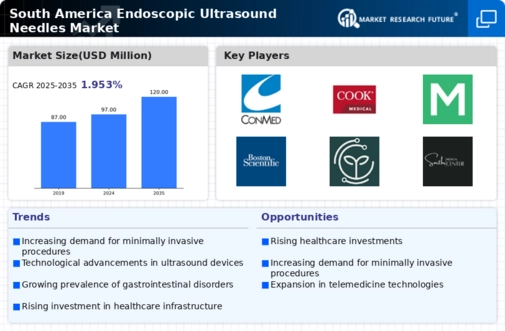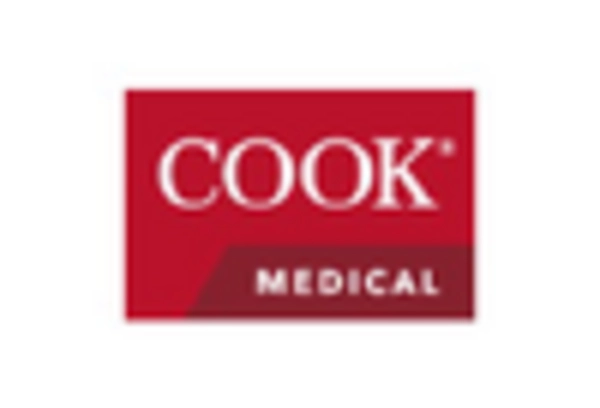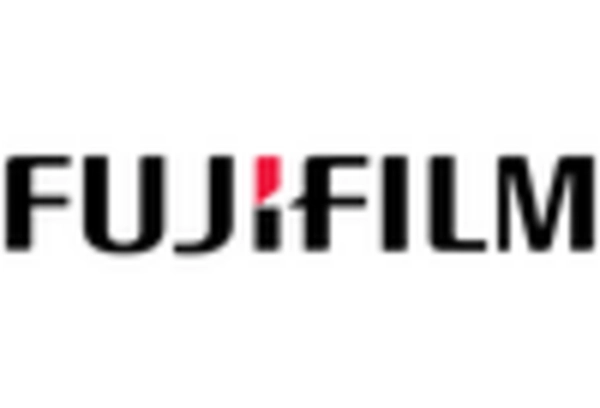Government Initiatives and Support
Government initiatives and support for healthcare advancements are pivotal in shaping the endoscopic ultrasound-needles market in South America. Various countries in the region are implementing policies aimed at improving healthcare access and quality, which includes the promotion of advanced diagnostic technologies. For instance, funding programs and subsidies for healthcare facilities to acquire modern medical equipment are becoming more prevalent. These initiatives are expected to increase the adoption of endoscopic ultrasound-needles, as healthcare providers are encouraged to utilize cutting-edge tools for better patient care. Additionally, public health campaigns aimed at raising awareness about the benefits of early diagnosis are likely to further stimulate market growth.
Expansion of Healthcare Infrastructure
The ongoing expansion of healthcare infrastructure in South America plays a crucial role in the growth of the endoscopic ultrasound-needles market. Governments and private entities are investing significantly in healthcare facilities, aiming to improve access to advanced medical technologies. This investment is expected to reach approximately $10 billion by 2026, facilitating the acquisition of modern diagnostic equipment, including endoscopic ultrasound-needles. Enhanced healthcare infrastructure not only increases the availability of these tools but also promotes training and education for healthcare professionals, ensuring they are well-equipped to utilize such technologies effectively. Consequently, this expansion is likely to drive the demand for endoscopic ultrasound-needles, as more facilities adopt these innovative solutions.
Increase in Chronic Disease Prevalence
The rising prevalence of chronic diseases in South America is a significant driver for the endoscopic ultrasound-needles market. Conditions such as cancer, gastrointestinal disorders, and cardiovascular diseases are becoming increasingly common, necessitating advanced diagnostic and therapeutic interventions. According to recent statistics, the incidence of gastrointestinal cancers has increased by approximately 15% in the last decade. This trend underscores the need for effective diagnostic tools, such as endoscopic ultrasound-needles, which enable precise tissue sampling and diagnosis. As healthcare providers seek to improve patient outcomes through early detection and intervention, the demand for these needles is expected to rise, thereby bolstering the market.
Technological Innovations in Medical Devices
Technological innovations in medical devices are significantly influencing the endoscopic ultrasound-needles market in South America. The introduction of advanced needle designs, such as those with enhanced maneuverability and precision, is likely to improve diagnostic accuracy and patient safety. Furthermore, the integration of imaging technologies with endoscopic ultrasound-needles is expected to facilitate real-time visualization during procedures, enhancing the overall effectiveness of interventions. As manufacturers continue to invest in research and development, the market is poised for growth, with new products expected to enter the market by 2027. This continuous innovation is likely to attract healthcare providers seeking to adopt the latest technologies, thereby driving the demand for endoscopic ultrasound-needles.
Rising Demand for Minimally Invasive Procedures
The endoscopic ultrasound-needles market in South America is experiencing a notable surge in demand for minimally invasive procedures. This trend is largely driven by the increasing preference among healthcare providers and patients for techniques that reduce recovery time and minimize surgical risks. As a result, the market for endoscopic ultrasound-needles is projected to grow at a CAGR of approximately 8% over the next five years. The shift towards outpatient care and the rising incidence of chronic diseases necessitate the use of advanced diagnostic tools, further propelling the endoscopic ultrasound-needles market. Additionally, the growing number of specialized clinics and hospitals equipped with state-of-the-art technology is likely to enhance the adoption of these needles, thereby contributing to market expansion.


















Leave a Comment